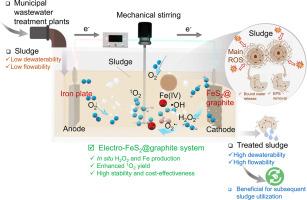Overlooked role of singlet oxygen in electrochemical processes for efficient sludge dewatering at neutral pH
IF 12.4
1区 环境科学与生态学
Q1 ENGINEERING, ENVIRONMENTAL
引用次数: 0
Abstract
Conventional hydroxyl radical (•OH)-based treatments (i.e., iron-based advanced oxidation technologies (Fe-AOTs) and electrochemical processes) are generally considered efficient approaches for sludge dewatering via destroying the stable extracellular polymeric substances (EPS) structure in sludge. However, extremely acidic conditions (i.e., pH 2.8–3.2) in such processes hinder their commercial viability, primarily due to corrosive and environmental issues. Singlet oxygen (1O2), known for its selective oxidation and environmental stability, can break down protein structures even at low levels. 1O2-based processes may enable efficient sludge dewatering under neutral conditions by disrupting complex EPS structures. Therefore, in this study, we for the first time proposed a 1O2-based electrochemical process with a catalytic cathode of pyrite-modified graphite (electro-FeS2@graphite) for sludge dewatering under neutral conditions. Results showed that under optimized conditions, the electro-FeS2@graphite system achieved superior sludge dewatering (47.9% water content over ten cycles) compared to existing Fe-AOTs and electrochemical methods. Electron paramagnetic resonance, quenching tests, and reactive oxygen species probes confirmed that the FeS2@graphite catalytic cathode mainly generated 1O2 species for efficiently eliminating hydrophilic aromatic structures and enhancing sludge dewatering without pH regulation. A three-step mechanism was proposed for the enhanced sludge dewaterability in the electro-FeS2@graphite system: (i) in situ high H2O2 yield at FeS2@graphite cathode, (ii) considerable 1O2 generation within the system, and (iii) selective attack on hydrophilic aromatic structures by 1O2. The operational cost of the proposed system was also substantially lower than that of the above-mentioned treatments. Overall, these findings highlight the effectiveness of 1O2-based electrochemical process in achieving stable and cost-effective sludge dewatering without acidification.

单线态氧在中性pH下污泥高效脱水的电化学过程中被忽视的作用
传统的基于羟基自由基(•OH)的处理(即基于铁的高级氧化技术(Fe-AOTs)和电化学过程)通常被认为是通过破坏污泥中稳定的细胞外聚合物(EPS)结构来实现污泥脱水的有效方法。然而,由于腐蚀和环境问题,这种工艺中的极端酸性条件(即pH值2.8-3.2)阻碍了它们的商业可行性。单线态氧(1O2)以其选择性氧化和环境稳定性而闻名,即使在低水平下也能分解蛋白质结构。基于o2的工艺可以通过破坏复杂的EPS结构,在中性条件下实现有效的污泥脱水。因此,在本研究中,我们首次提出了一种在中性条件下以硫铁矿改性石墨(electro-FeS2@graphite)为催化阴极的基于o2的污泥脱水电化学工艺。结果表明,在优化条件下,electro-FeS2@graphite系统的污泥脱水效果优于现有的fe - aot和电化学方法(10次循环含水率47.9%)。电子顺磁共振、淬火试验和活性氧探针证实FeS2@graphite催化阴极主要产生1O2种,在不调节pH的情况下有效去除亲水芳香族结构,增强污泥脱水。提出了electro-FeS2@graphite系统中提高污泥脱水能力的三步机制:(i) FeS2@graphite阴极原位高H2O2产率,(ii)系统内大量的1O2生成,以及(iii) 1O2选择性地攻击亲水芳香结构。拟议系统的运行费用也大大低于上述处理的费用。总的来说,这些发现突出了基于o2的电化学工艺在实现稳定且经济高效的污泥脱水而不酸化方面的有效性。
本文章由计算机程序翻译,如有差异,请以英文原文为准。
求助全文
约1分钟内获得全文
求助全文
来源期刊

Water Research
环境科学-工程:环境
CiteScore
20.80
自引率
9.40%
发文量
1307
审稿时长
38 days
期刊介绍:
Water Research, along with its open access companion journal Water Research X, serves as a platform for publishing original research papers covering various aspects of the science and technology related to the anthropogenic water cycle, water quality, and its management worldwide. The audience targeted by the journal comprises biologists, chemical engineers, chemists, civil engineers, environmental engineers, limnologists, and microbiologists. The scope of the journal include:
•Treatment processes for water and wastewaters (municipal, agricultural, industrial, and on-site treatment), including resource recovery and residuals management;
•Urban hydrology including sewer systems, stormwater management, and green infrastructure;
•Drinking water treatment and distribution;
•Potable and non-potable water reuse;
•Sanitation, public health, and risk assessment;
•Anaerobic digestion, solid and hazardous waste management, including source characterization and the effects and control of leachates and gaseous emissions;
•Contaminants (chemical, microbial, anthropogenic particles such as nanoparticles or microplastics) and related water quality sensing, monitoring, fate, and assessment;
•Anthropogenic impacts on inland, tidal, coastal and urban waters, focusing on surface and ground waters, and point and non-point sources of pollution;
•Environmental restoration, linked to surface water, groundwater and groundwater remediation;
•Analysis of the interfaces between sediments and water, and between water and atmosphere, focusing specifically on anthropogenic impacts;
•Mathematical modelling, systems analysis, machine learning, and beneficial use of big data related to the anthropogenic water cycle;
•Socio-economic, policy, and regulations studies.
 求助内容:
求助内容: 应助结果提醒方式:
应助结果提醒方式:


